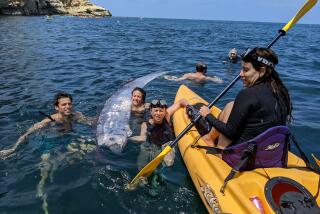Great white shark bites man’s kayak, leaves two teeth behind off Catalina Island
A great white shark left behind two great big teeth after chomping into a scuba diver’s kayak off Catalina Island at Camp Emerald Bay.
While kayaking Saturday near Ship Rock — an open-water diving spot roughly three miles from Emerald Bay — San Diego resident Danny McDaniel felt something push against his vessel. He thought the shove came from his friend, but he soon saw the head of a great white shark envelop the back of his kayak. McDaniel froze.
“I saw the snout of the shark over the back of the kayak,” he said. “Then I followed the snout up and there’s a giant, immense body off to the right side of the boat.”
John Chambers watched his friend’s encounter with the shark from about 25 feet away, shouting at him to hit the shark on head. The shark bit into the vessel, then swam away, leaving behind two teeth.
McDaniel said the experience lasted only seconds, but he knows precisely when it occurred thanks to a fitness tracker.
“My heart jumped at 4:30 exactly, about 150 yards west from Ship Rock.”
The shark didn’t aggressively whip its head back and forth, but it did push McDaniel hard enough that his kayak rotated 180 degrees. The force is also what likely caused the shark’s teeth to pop off. At roughly 2-inches each, preliminary calculations suggest that the shark was about 19 feet long.
McDaniel, who has a large shark tattoo on his chest, has dived for more than 20 years and has swum with several sharks. But he’s never encountered one this large.
Great white shark sightings are not uncommon at Catalina Island. There were about a dozen accounts this summer, said Chris Lowe, a professor of marine biology and director of the Shark Lab at Cal State Long Beach.
Lowe said this particular shark has been spotted off Catalina several times over the last two weeks. Lowe and his staff plan to try to find it Wednesday morning in an effort to tag the predator and better understand its patterns as well as to determine whether a subpopulation of great whites exist in the Channel Islands.
“This is the new normal. We have to share the ocean with them,” he said. “We should always be thinking there may be sharks here — but that doesn’t necessarily mean we should be scared.”
Great whites make themselves seen when they’re curious. But contrary to popular depiction, Lowe said, they are typically shy and coy.
“The nature of being an ambushed creature,” he explained.
The sharks have been protected in California since 1994. Before that, they were hunted and fished.
Shark attacks around Catalina Island are rare but have occurred. In 2008, a kayaker was thrown into the air when a shark bumped into her. In 2012, a shark bit a 15-year-old girl’s paddleboard about a mile from the Avalon area.
Lowe recommends people stick together when in the water and stay away from areas where sharks may feed. But he doesn’t think people should be deterred from water activities.
McDaniel certainly wasn’t. Three hours after his encounter with the great white, he and Chambers were back in the water for a night dive, this time without a shark in sight.
More to Read
Sign up for Essential California
The most important California stories and recommendations in your inbox every morning.
You may occasionally receive promotional content from the Los Angeles Times.











